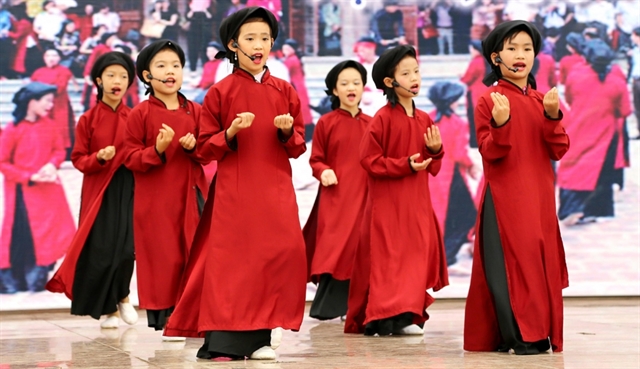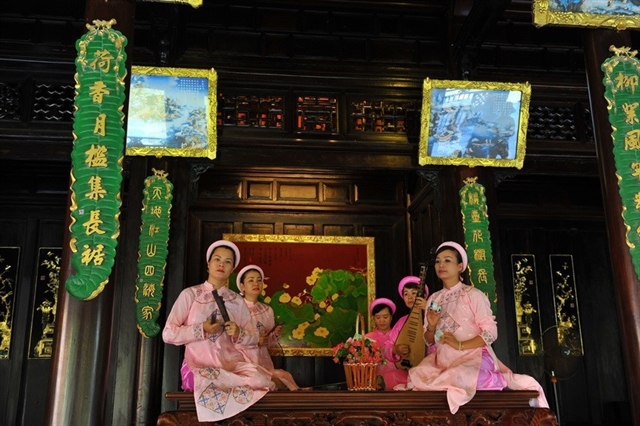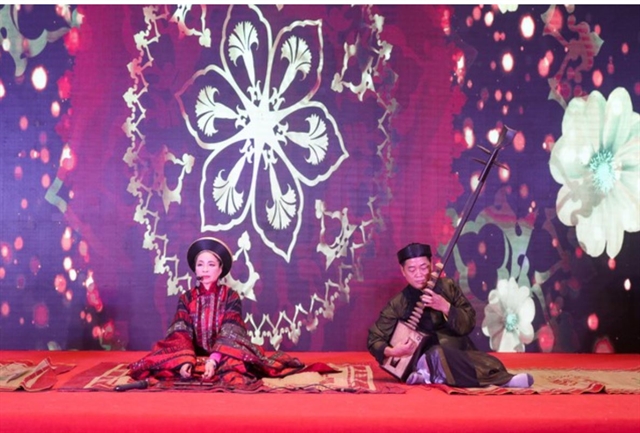 Sunday/Weekend
Sunday/Weekend

 |
| LADIES IN RED: Youngsters perform Phú Thọ 'xoan' singing - a UNESCO intangible cultural heritage. Photo vov.vn |
The participation of the local community in the process of intangible cultural heritage preservation will help solve problems in protecting and developing heritage values, experts have said.
Bùi Hoài Sơn, permanent member of the National Assembly's Culture and Education Committee, said that to improve the protection and development of intangible cultural heritage, the community must participate in discussing, evaluating and organising activities in preserving and promoting the intangible cultural heritage. He also said the community must be able to benefit from those activities.
"Local residents should organise traditional festivals by themselves. As there is not too much State 'intervention' in the organisation of local festivals, they will not create a 'fake' atmosphere for visitors," Sơn said.
He suggested attaching traditional cultural activities to heritage sites, where local people must actively participate in. Instead of intervening in people's cultural activities, local authorities should create a policy framework to promote intangible cultural heritage.
 |
| HERITAGE PERFORMANCE: 'Nhã nhạc' (Elegant music) inscribed on the Representative List of the Intangible Cultural Heritage of Humanity in 2008, refers to a broad range of musical and dance styles performed at the Vietnamese royal court from the 15th to the mid-20th century. VNA/VNS Photo |
"Local authorities thus need to create policy corridors for promoting heritage values. In the initial stage, they need to issue policy documents that encourage people to participate in the work of preserving their own heritage, pointing out the benefits of their participation, as well as having specific directions so that people can easily take part in pilot activities that will serve as models for future programmes," Sơn said.
According to Nguyễn Đắc Thủy, director of the northern province of Phú Thọ's Department of Culture, Sports and Tourism, investing in education for the next generation is the "root" of development.
To develop all types of intangible cultural heritage, the top goal currently is to invest in classes to teach younger generations about heritage values and to practise or perform to ensure their inherent "style and appearance".
Thủy and Sơn gave their opinions at a workshop held in mid-December: "20 Years of Protecting Intangible Cultural Heritage in Việt Nam: From UNESCO to the Community," highlighting local community participation in protecting intangible cultural heritage.
Heritage protection success
At the workshop, experts discussed the role of the local community in heritage preservation, as well as the process of practising traditions.
Thủy reported on the successes that Phú Thọ Province gained in protecting and preserving intangible cultural heritage, particularly the removal of UNESCO-recognised xoan singing from the list of Intangible Cultural Heritages needing urgent protection.
Phú Thọ's folk singing was then named on the representative list of Intangible Cultural Heritage of Humanity of the UN culture agency.
"Phú Thọ Province's conservation efforts and solutions have been honoured by UNESCO as Việt Nam's typical examples and valuable experience in protecting heritages in emergency around the world," Thủy said.
In 2017, the Intergovernmental Committee of the 2003 Convention on the Protection of Intangible Cultural Heritage issued a decision removing Phú Thọ's xoan singing from the list of heritages in need of urgent safeguarding.
"This has contributed to raising national awareness of how to deal with cultural heritage," Thủy said.
To achieve such a result, Thủy said, Phú Thọ had proactively developed a plan to preserve and promote the value of xoan singing for five years with specific measures, including support policies for senior master artists and training the young to become the next generation of artisans.
The province had also organised folk singing classes right in its native places; restored cultural space and ritual practices related to folk singing; and promoted community awareness of the value of the art form.
Xoan singing had also been performed and taught at schools to help restore and create strong vitality and sustainability for the folk singing heritage.
 |
| FOLK DUET: 'Ca trù' (ceremonial singing) is an intangible cultural heritage that needs urgent protection in Việt Nam. Photo bvhttdl.gov.vn |
'Living heritage'
Another workshop jointly held in December by the culture ministry's Department of Cultural Heritage and the British Council at the Temple of Literature heritage site in Hà Nội, affirmed the role of the local community as the "holder and practitioner" of heritage.
Lê Thị Thu Hiền, director of the Department of Cultural Heritage, highlighted intangible cultural heritage or "living heritage" as creating opportunities for communities and individuals to realise their identity and continuity, promoting social cohesion, respecting cultural diversity and human creativity, and enhancing community connection.
In 2001, the issue of intangible cultural heritage in Việt Nam was brought into law. In 2005, Việt Nam was one of 30 member countries to early join the UNESCO's 2003 Convention on the Protection of Intangible Cultural Heritage.
Up to now, after 18 years of participation, the country has always striven to be a responsible member in implementing and promoting the development of the convention.
Honoured to be elected twice as a member of the Intergovernmental Committee of the 2003 Convention, with 15 intangible cultural heritages registered by UNESCO, Việt Nam has effectively protected and promoted its role according to national action programmes on heritage protection.
Intangible cultural heritage has asserted its role in socio-cultural life, contributing to economic development.
Intangible cultural heritage has been observed and passed down from generation to generation and is constantly recreated by the community to adapt to the environment, forming a sense of identity and continuity, thereby raising respect for cultural diversity and creativity. VNS




